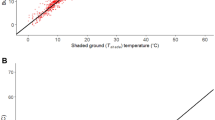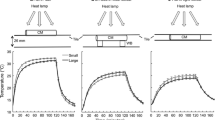Summary
European green lizards, Lacerta viridis, show a distinct annual cycle in their day and nighttime selected body temperature (T b) levels when monitored under natural photoperiod. The amplitude between daily photophase and scotophase temperatures varies throughout the year. Highest body temperatures with smallest day/night variation are selected from May through July. Throughout fall, the difference between day and nighttime selected T b levels increases. Lizards inevitably enter a state of winter dormancy which terminates daily rhythmicity patterns. Under natural photoperiodic conditions, cessation of dormancy occurs spontaneously by mid-March, regardless whether high temperatures are available or not. Lacerta viridis respond to an artificial long photoperiod (16 h light, 8 h dark) at all times of the year with modifications in both diel patterns and levels of selected T b to summer-like conditions. When, however, the natural photoperiod at different phases in the annual cycle is held constant for six to eight weeks, T b selection of Lacerta viridis also remains stable at the level corresponding to the prevailing photoperiod. These results implicate that the photoperiod is a more prominent Zeitgeber for seasonal cueing of temperature selection than has been surmised in the past. Further, we suggest that the large variations recorded in daily T b cycles do not imply that this lizard is an “imprecise” thermoregulator, but rather indicates an important integral process necessary for seasonal acclimatization.
Similar content being viewed by others
References
Baker LA, White FN (1970) Redistribution of cardiac output in response to heating in Iguana iguana. Comp Biochem Physiol 35:253–262
Ballinger RE, Hawker J, Sexton OJ (1969) The effect of photoperiod acclimation on the thermoregulation of the lizard, Sceloporus undulatus. J Exp Zool 171:43–48
Bartholomew GA (1982) Physiological control of body temperature. In: Gans C, Pough FH (eds) Biology of the reptilia, vol 12. Academic Press, London New York, pp 167–212
Bowker RG (1984) Precision of thermoregulation of some African lizards. Physiol Zool 57:401–412
Brattstrom BH (1965) Body temperature of reptiles. Am Midl Nat 73:376–422
Case TJ (1976) Seasonal aspects of thermoregulatory behaviour in the chuckawalla, Sauromalus obesus (Reptilia, Lacertilia, Iguanidae). J Herpertol 10:85–95
Cowgell J, Underwood H (1979) Behavioral thermoregulation in lizards: a circadian rhythm. J Exp Zool 210:189–193
Cowles RB, Bogert CM (1944) A preliminary study on the thermal requirements of desert reptiles. Bull Am Mus Hist 83:267–296
Damme R Van, Bauwens D, Verheyen RF (1986) Selected body temperatures in the lizard Lacerta vivipara: variation within and between populations. J Therm Biol 11:219–222
DeWitt CB (1967) Precision of thermoregulation and its relation to environmental factors in the desert iguana, Dipsosaurus dorsalis. Physiol Zool 40:49–66
Engbretson G, Hutchison VH (1976) Parietalectomy and thermal selection in the lizard Sceloporus magister. J Exp Zool 198:29–38
Garrick LD (1972) Temperature influences on hibernation in Sceloporus occidentalis. J Herpetol 6:195–198
Gregory PT (1982) Reptilian hibernation. In: Gans C, Pough FH (eds) Biology of the reptilia, vol 13. Academic Press, London New York, pp 53–154
Huey RB (1982) Temperature, physiology, and ecology of reptiles. In: Gans C, Pough FH (eds) Biology of the reptilia, vol 12. Academic Press, London New York, pp 25–91
Huey RB, Slatkin M (1976) Cost and benefits of lizard thermoregulation. Q Rev Biol 51:363–384
Hutchison VH (1979) The concept of critical thermal maximum. Am J Physiol 237:367–368
Hutchison VH, Ferrance MR (1970) Thermal tolerance of Rana pipiens acclimated to daily temperature cycles. Herpetologica 26:1–8
Hutchison VH, Kosh RJ (1974) Thermoregulatory function of the parietal in the lizard Anolis carolinensis. Oecologia (Berlin) 16:173–177
Hutchison VH, Maness JD (1979) The role of behavior in temperature acclimation and tolerance in ectotherms. Am Zool 19:367–384
Korsós Z (1982) Field observations on two lizard populations (Lacerta viridis Laur. and Lacerta agilis L.). Vertebrata Hungarica 21:185–194
Korsós Z (1984) Comparative niche analysis of two sympatric lizard species (Lacerta viridis and Lacerta agilis). Vertebrata Hungarica 22:5–14
Kour EL, Hutchison VH (1970) Critical thermal tolerances and heating and cooling rates of lizards from diverse habitats. Copeia 1970:219–229
Lashbrook MK, Livezey RL (1970) Effects of photoperiod on heat tolerance in Sceloporus occidentalis occidentalis. Physiol Zool 43:38–46
Lee JC (1980) Comparative thermal ecology of two lizards. Oecologia (Berlin) 44:171–176
Licht P (1968) Response of the thermal preferendum and heat resistance to thermal acclimation under different photoperiods in the lizard Anolis carolinensis. Am Midl Nat 79:149–158
Licht P, Dawson WR, Shoemaker VH, Main AR (1966) Observations on the thermal relations of Western Australian lizards. Copeia 1966:97–110
Maderson PFA, Bellairs A d'A (1962) Culture methods as an aid to experiment on reptile embryos. Nature 195:401–402
Mayhew WW (1963) Temperature preference of Sceloporus orcutti. Herpetologica 18:217–233
Mayhew WW (1965) Hibernation in the horned lizard, Phrynosoma m'calli. Comp Biochem Physiol 16:103–119
McGinnis SM (1966) Scetoporus occidentalis: preferred body temperature of the western fence lizard. Science 153:1090–1091
Mertens R, Schnurre O (1949) Eidonomische und Ökologische Studien an Smaragdeidechsen Deutschlands. Abh Senckenbergisch Naturforsch Gesell 1949:5–25
Morgareidge KR, White FN (1969) Cutaneous vascular changes during heating and cooling in the Galapagos marine iguana. Nature 223:587–591
Mueller CF (1970) Temperature acclimation in two species of Sceloporus. Herpetologica 26:83–85
Patterson JW, Davies PMC (1978) Preferred body temperature: seasonal differences in the lizard, Lacerta vivipara. J Therm Biol 3:39–42
Pough FH, Gans C (1982) The vocabulary of reptilian thermoregulation. In: Gans C, Pough FH (eds) Biology of the reptilia, vol 12. Academic Press, London New York, pp 17–24
Rand AS (1964) Ecological distribution in anoline lizards of Puerto Rico. Ecology 45:745–752
Rismiller PD, Heldmaier G (1982) The effect of photoperiod on temperature selection in the European green lizard, Lacerta viridis. Oecologia (Berlin) 53:222–226
Rismiller PD, Heldmaier G (1985) Thermal behavior as a function of the time of day. Heat exchange rates and oxygen consumption in the lacertid lizard, Lacerta viridis. Physiol Zool 58:71–79
Rismiller PD, Heldmaier G (1986) Seasonal responses to heating and cooling in Lacerta viridis. In: Rocek Z (ed), Studies in Herpetology. Charles University, Prague, pp 467–471
Roth JJ, Ralph CL (1976) Body temperature of the lizard Anolis carolinensis: effect of parietal ectomy. J Exp Zool 198:17–28
Ruf T, Heldmaier G (1987) Computerized body temperature telemetry in small animals: use of simple equipment and advanced noise suppression. Comput Biol Med (in press)
Ruibal R (1961) Thermal relations of five species of tropical lizards. Evolution 15:98–111
Saint-Girons MC, St. Girons H (1956) Cycle d'activité et thermorégulation chez les reptiles. Vie et Milien 7:133–226
Smith EN (1976) Heating and cooling rates of the American alligator, Alligator mississippiensis. Physiol Zool 49:38–48
Spellerberg I (1976) Adaptations of reptiles to cold. In: Bellairs A d'A, Cox CB (eds) Morphology and biology of reptiles, vol 3. Academic Press, London New York, pp 261–285
Stebbins RC (1963) Activity changes in the striped plateau lizard with evidence on influence of the parietal eye. Copeia 4:681–691
Weber H (1957) Vergleichende Untersuchung des Verhaltens von Smaragdeidechsen (Lacerta viridis), Mauereidechsen (L. muralis) and Perleidechsen (L. lepida). Z Tierpsych 14:448–472
White FN (1970) Central shunts and their control in reptiles. Fed Proc 29:1149–1153
White FN (1976) Circulation. In: Gans C, Pough FH (eds) Biology of the reptilia, vol 12. Academic Press, London New York, pp 275–335
Author information
Authors and Affiliations
Rights and permissions
About this article
Cite this article
Rismiller, P.D., Heldmaier, G. How photoperiod influences body temperature selection in Lacerta viridis . Oecologia 75, 125–131 (1988). https://doi.org/10.1007/BF00378825
Received:
Issue Date:
DOI: https://doi.org/10.1007/BF00378825




